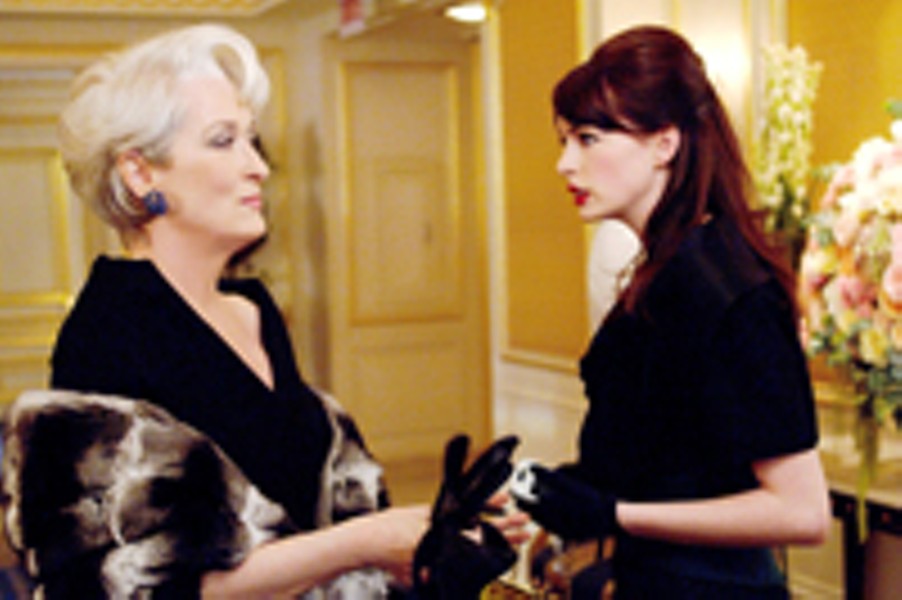The Devil Wears Prada(PG-13), directed by David Frankel, is now playing at Culver Ridge 16, Pittsford Cinemas, Henrietta 18, Webster 12, Tinseltown, Greece Ridge 12, and Eastview 13.
The elegant boss from Hell
A movie about the world of fashion probably must include a defense of its subject against the inherent and inevitable charge of utter triviality. And to its credit, I suppose, The Devil Wears Prada provides one. Near the beginning of the movie Meryl Streep, playing Miranda Priestly, the editor of the top fashion magazine in New York --- and therefore the world --- delivers a sharp rebuke (one of many) to her new gofer, Andrea Sachs (Anne Hathaway), when the young woman snickers at the seriousness with which Miranda and her sycophants regard the difference between two virtually identical belts. She discourses on the history of cerulean, as if it were some new invention, from a top designer's choice of that particular shade of blue for one of his exclusive collections, to its percolation down to the mass market, mentioning of course that the introduction of that color resulted in the sale of millions of items and the employment of thousands of people.
The pedantic little essay might attain a greater height of moral uplift if nobody knew of the sweatshops employing those thousands of people, nor the absolute shallowness of those who adorn themselves in the designer's collection, nor the selfishness and cruelty of the woman teaching the lesson in free market capitalism, full employment, and the glories of cerulean blue. The contrast between those two perceptions of the world of fashion, though not always in evidence, propels the plot and characters of the movie; it also constitutes the major intellectual and emotional dilemma for its young protagonist.
The movie itself follows a most familiar pattern, showing the initiation of an able, ambitious young woman into the customs of a special culture, and the conduct of some special people. Cold, imperious, and tyrannical, Miranda Priestly rules her magazine, her employees, and the fashion culture of New York like some mad, mercurial despot. In addition to insisting that Andrea run all sorts of personal and professional errands, obey precisely even the most bizarre commands, and anticipate her every whim, she even sets her on one of those apparently impossible challenges right out of some dark fairy tale.
As Andrea learns the intricacies of the fashion business and learns how to cope with her horrible boss, she grows in confidence. With the help of a sympathetic photography editor (Stanley Tucci), she also acquires a new look and a new sense of style. She meets a great many rich and famous people, attends some trendy social gatherings, and attracts the attention of a successful writer (Simon Baker). She performs so well in her job that Miranda brings her to Paris for the fall fashion shows, a great step forward in her career.
At the same time, the job requires so much of her time and energy that Andrea ultimately alienates her friends and loses her boyfriend. The usual conflict between personal and professional fulfillment also involves the recognition that she has abandoned her ambitions as a journalist and her principles as a human being. Echoing the Satanic promise (the devil really does wear Prada), Miranda offers her the great cities of the world --- in this case New York and Paris --- and a brilliant destiny.
Fresh from her impersonation of a country singer in A Prairie Home Companion, Meryl Streep once again exhibits her remarkable versatility, with an icy beauty and an unrelenting nastiness. The lovely, shapely Anne Hathaway projects a certain sense of innocence and good humor in a rather passive character, but of course cannot really compete with Streep's powerful presence and Arctic scorn.
A movie so deeply engaged with fashion necessarily exploits to the fullest its visual glamor, emphasizing, often in energetic montage, the beauty of the people, the clothes, the furnishings, the exterior and interior of some stunning locations in Manhattan and Paris. Not surprisingly, the picture also resembles an extended, animated series of advertisements for upscale goods, with incessant name dropping, designer brands, and the constant display of shop windows --- it's the longest, richest example of product placement in recent film history. Watching it seems a little like flipping through a slick magazine, with bits of editorial content interfering with the kaleidoscope of dazzling color, extreme clothing, and overpriced luxuries, an ultimately distasteful celebration of materialism and consumerism, despite those thousands of workers.
